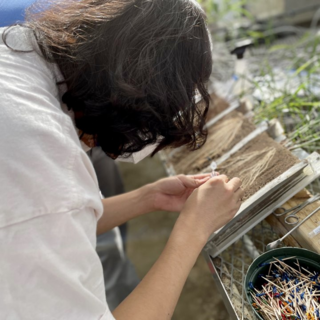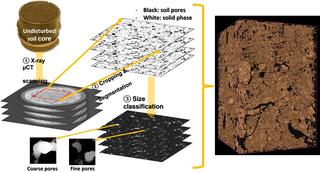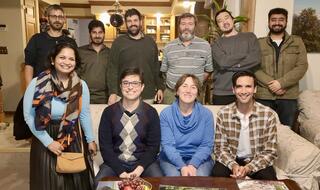
Our students and postdoctoral researchers play an enormous role in the transition to a sustainable, resilient, and affordable energy future that is centered on social and economic equality. From lab experiments to field work to classrooms, these leaders of today and tomorrow are our catalysts for energy discovery.
In this series, we learn more about what inspired these talented researchers, what brought them to their field of study, and the questions that drive their work at the Great Lakes Bioenergy Research Center (GLBRC).
This week, we spoke with JinHo Lee, a Ph.D. student in the Kravchenko Lab at Michigan State University, who is working to understand soil carbon sequestration and soil pores. Lee obtained his BS and MS in applied life chemistry from Gyeongsang National University in his home country of South Korea.
Can you tell me about your research in the Kravchenko Lab at MSU?
My research interest is in soil carbon. I look at factors that can improve soil carbon sequestration, soil quality, and fertility. Specifically, I'm looking at soil pores and the mechanisms of the soil carbon cycle.
What are soil pores?
Soil pores are basically holes in the soil. They can function as a habitat for microorganisms and as channels for water and nutrient supply. Also, they can store carbon that plants take from the atmosphere.
We are finding that the finer and smaller pores store carbon. Medium pores provide the proper habitats for microorganisms. Larger pores can function as channels for the supply of water and nutrients. Generally, we observe this, but we cannot exactly define size as a function of storage or channels.

How is this research impactful?
One of the main projects working with GLBRC is to reveal the soil benefits of bioenergy crops. The fundamental benefit of biofuel and bioenergy crops is to alleviate climate change by reducing the dependency on fossil fuels. One way bioenergy crops do this is by building up soil carbon. By gaining a better understanding of soil environments we can find ways to take in more atmospheric carbon dioxide and store it in the soil. I believe bioenergy is the only sustainable energy source that can reduce both the emission of carbon dioxide and current atmospheric carbon dioxide.
How did you get interested in soil science and bioenergy?
I am from South Korea, which is a really small country so it's actually not suitable for growing bioenergy crops. As an undergraduate and graduate student in South Korea, I estimated greenhouse gas emissions from agriculture sectors, especially from flooded paddy soils and looked at their impact.
But, I really wanted to go into research that looked at the mechanisms, rather than solely focusing on the measurements. I wanted to explain more than just the measurements of greenhouse gas and look at the why. I found the Kravchenko Lab focused on the mechanistic cycling of soil carbon and I was very interested.
You did both your undergraduate and graduate degrees in South Korea, and now you have been researching in the United States at Michigan State University (MSU) since 2019. How was this transition and how have these two experiences differed?
To be honest, it was not easy. The environment, the atmosphere, the people, the culture, and foods were all different. Even though my favorite food is cheeseburgers.
In terms of research, the main thing I did in graduate school in South Korea was look at emissions from agriculture and their impact. But here, I am revealing reasons. There are a lot more questions to be answered because no one knows about this yet, and that makes the approach different.
The research techniques are totally different from my home country. I spent almost two years learning new techniques. For example, when I measured the greenhouse gas emissions from the soil in graduate school, we used chambers to collect gasses. But here, even though our lab is still measuring the greenhouse gas emissions from the soil, we are focusing more on the soil itself looking at soil pores directly. We use a micro-CT scanner to segment a certain size of the pore and directly look into its shape.
How do you use a CT scanner to look at soil pores?
We scan a column of soil using the CT scanner as you would use medically. We could get thousands of slices of the images by the depth. The empty space, the soil pores, and the solid space, the soil particles, have different colors.
By using image analysis software, we can segment the soil pores from the entire image and get 3D stacked images of the soil pore structures. We get a lot of information from the scanned and the segmented images – the size distributions and connectivity of the soil pores and other various soil structural characteristics, which cannot be obtained by bulk soil measurements.

What’s been a highlight of your time at MSU?
I am always happy to learn new things and share ideas. There are a number of interesting workshops and services that I can learn about here. Also, various conferences and meetings here always inspire me. Recently, I won second place in a presentation competition through the Soil Physics and Hydrology Division of the Soil Science Society of America.
What do you like to do for fun at MSU, outside of research?
I like playing soccer. I felt frustrated when I came here because my department didn’t have a soccer team. So now I’m playing for the agricultural economics soccer team. I also like to travel. The United States is a huge country so there are plenty of places to go. I got married last year, now I have a travel mate in this huge country.
